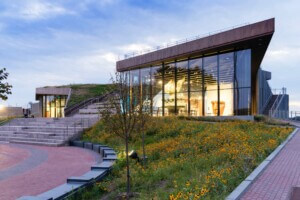Colorful birdhouses in myriad forms installed throughout Brooklyn Botanic Gardens (BBG) continue a millennia-old history of multi-species design. As part of the installation For the Birds, which opened June 11, the architect-designed objects hint at the potential for a more extensive cooperation between us humans and our animal neighbors. Despite mismatched schedules—the exhibition opened after the mating and nesting season for most birds—the follies nevertheless entertain visitors after cherry blossom season has ended and summer arrives, when the roses, Shakespeare Garden, and a garden for hummingbirds are all in bloom. More importantly, they offer speculation on how humans can better support biodiversity through design.
Participating artists and architects include Tatiana Bilbao, Bureau Spectacular, Steven Holl, landscape architect Walter Hood, Olalekan Jeyifous, Suchi Reddy, and SO–IL, among others. (Anticipatory cover of the show was previously shared in AN.) Studio Barnes’ pink-and-fuchsia birdhouse Fly South has arched pastel cubbyholes referencing Miami architecture, while Nina Cooke John’s Oh Robin! abstracts the nests of robins as a conceptual installation raised on a post. Sourabh Gupta’s woven takes inspiration from the sociability of sparrows, sculpting a communal birdhouse composed of a multiple entrance bulbous burlap and-husk construction.

The 33 participants selected songs to accompany the pieces from a 242-song soundtrack compiled by Randall Poster, film music supervisor for directors like Wes Anderson, Martin Scorsese, and Todd Haynes. Poster began his birdsong project after quarantines quieted the pervasive noise of traffic and industry, inspired by the increased audibility of birds during the pandemic. The songs are most newly written and recorded. Their sounds heighten the experience of wandering around the extensive 52 acres of gardens, turning it into a game to find the discrete art objects; once found, QR codes on the exhibition signs summon descriptions and audio files.
The history of birdhouses dates back to ancient civilizations. Archaeologists have documented multistory dovecotes and columbaria in ancient Egypt, Rome, and Iran contrived for bird nesting, attracting pigeons whose droppings were employed in agriculture. (Between 5,000 and 10,000 years ago, the pigeon became the world’s first domesticated bird.) In India, grand birdhouses called chabutras were built in stacked, tower-like shapes. Aside from chickens, the birdhouses we encounter today—in this exhibition or in backyards—arrive in a range of styles and sizes manufactured and sold by specialized birdhouse vendors. The MoMA Design Store sells a birdhouse that echoes early Bauhaus architecture; it can be converted into a bird feeder after mating season ends. From a multispecies design perspective, it’s a valid question whether homes for animals actually serve them or mainly exist to make people feel good without offering much help.
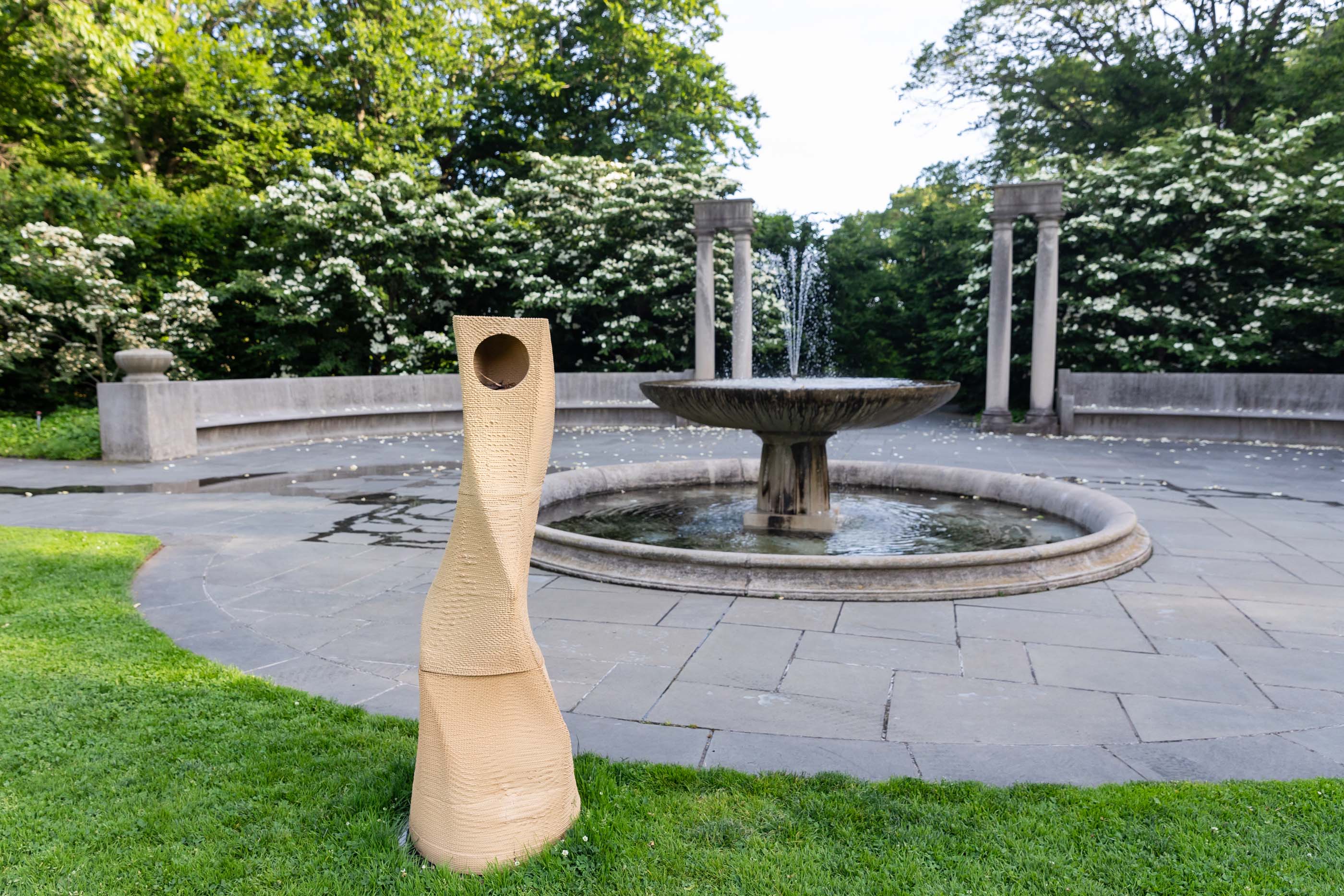
BBG’s birdhouses range from structures that, in principle, offer real nesting spaces designed for the needs of particular species to art-and-architecture constructions which communicate poignant messages about biodiversity but are not particularly useful to birds. They are better described as follies, a type of entertainment architecture with own rich history, dating back to at least the 18th century in the Western tradition. Their use in French and English gardens, often taking the form of Roman temples, Egyptian pyramids, and Gothic abbeys, were largely status symbols, sometimes bearing heraldic sculptures of birds and other animals. They served as decorative places to enhance appreciation of nature for people.
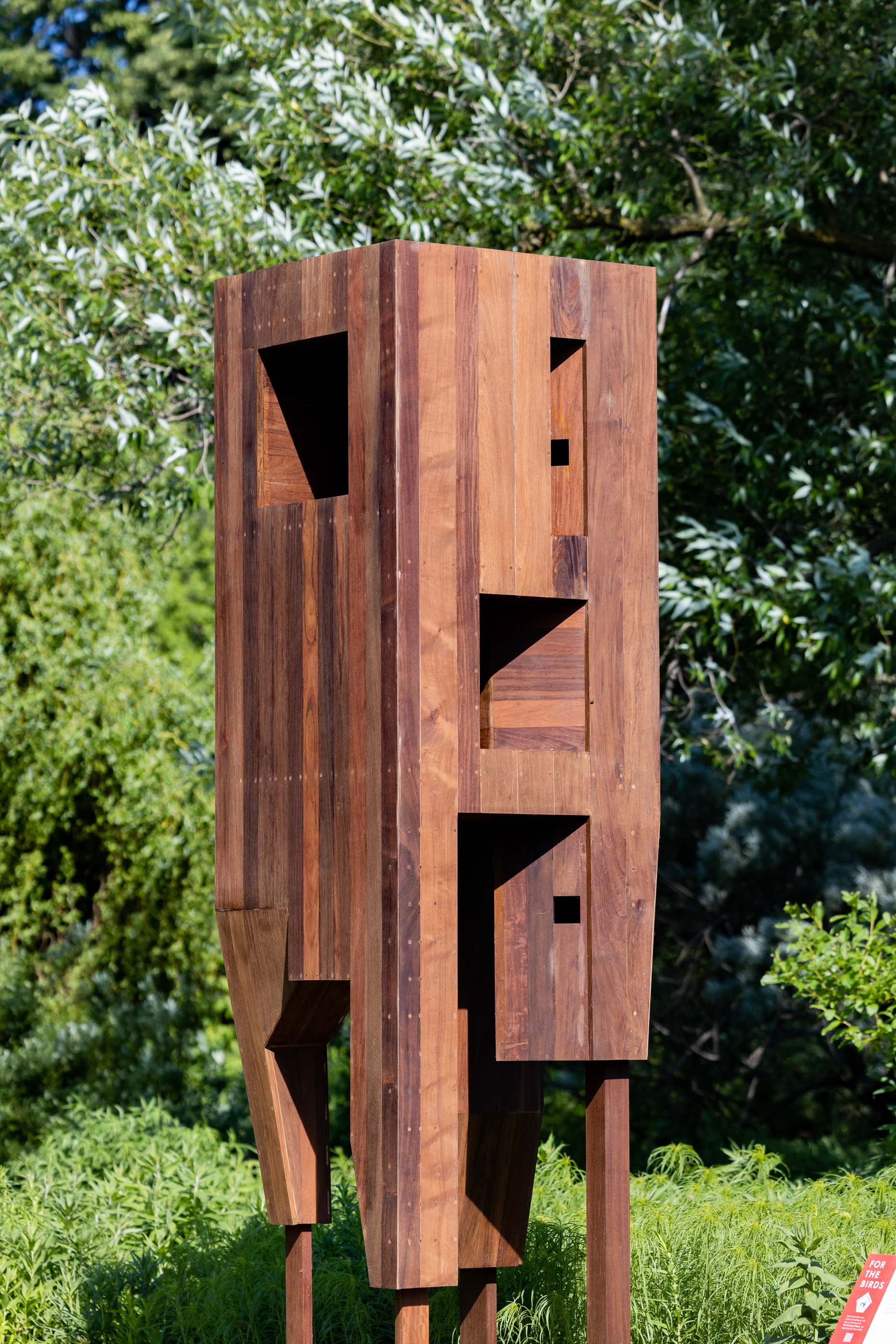
One designer, Joyce Hwang, associate professor and director of graduate studies with the Department of Architecture at the University of Buffalo, specializes in designing multispecies habitats. Through her practice Ants of the Prairie, Hwang has been researching and building animal habitats in parks and exhibitions for almost 20 years. Her projects include zoological laboratories, pest walls, bat clouds, beehives, bat towers, and niches for “non-charismatic” species which people normally don’t think about or want around. (Her work was featured in a short video produced for Built Ecologies: Architecture and Environment, a series from MoMA’s Emilio Ambasz Institute for the Joint Study of the Built and the Natural Environment.) She found early intellectual support for multispecies design thinking in the scholarship of architectural historian Catherine Ingraham, who studied convergences between architecture and other biological life in her 2006 book Architecture, Animal, Human: The Asymmetrical Condition. Her birdhouse, For Our Neighbors, is an intricate shingle-style structure with multiple shaded ledges.
At a moment when architects were absorbed in digital design tools, the works Ingraham wrote about tended to use nature as symbolism or employ biomimicry to iterate forms. Today, our ecological paradigms have shifted. Rather than being an inspirational source of patterning, conversations center on mass extinction caused by global warming. One approach, supported by biologist E.O. Wilson, is the creation of hands-off wilderness zones paired with the design of multispecies animal corridors and wild spaces throughout human settlements.
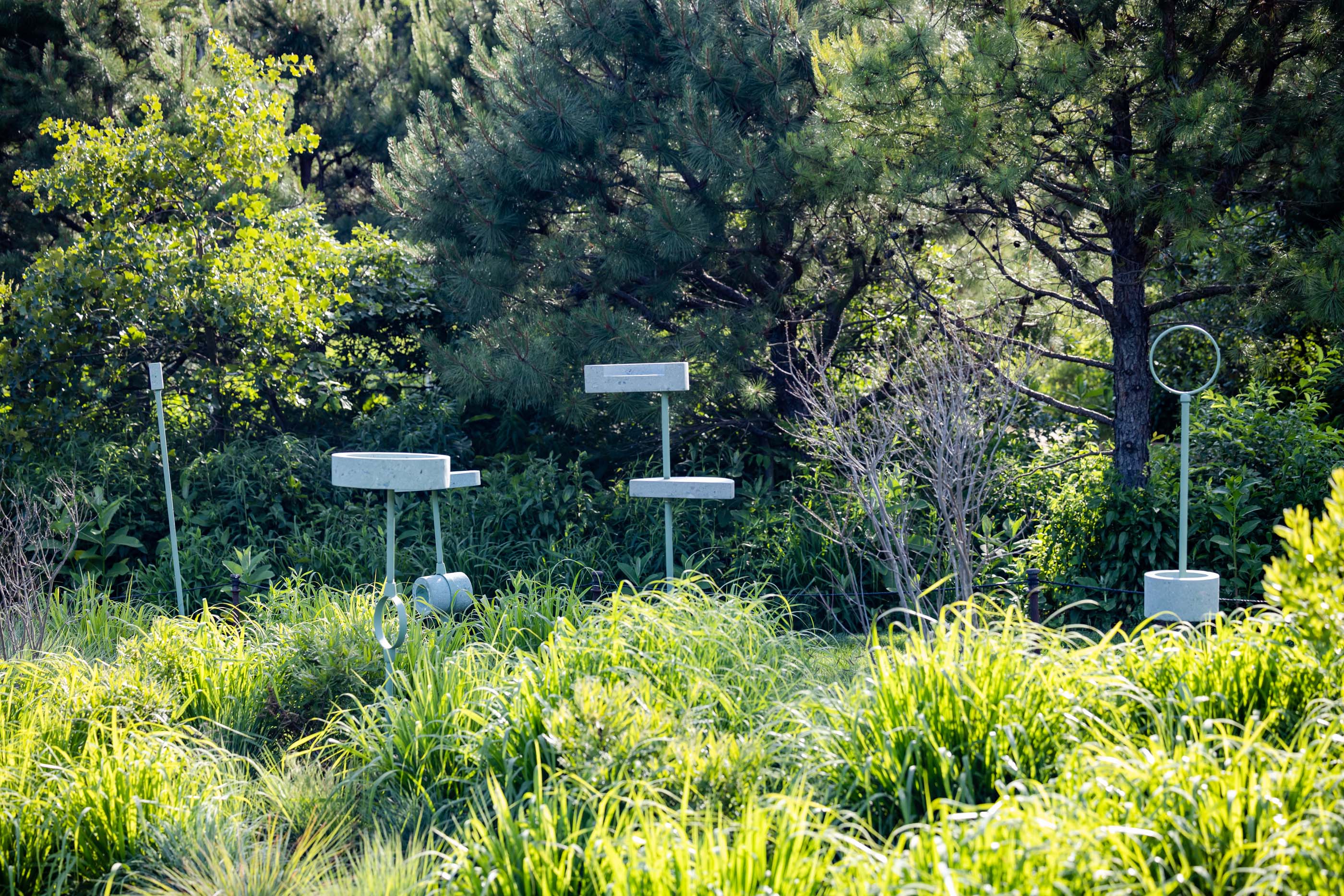
For the Birds opens a space for visitors to think about how we can build in a way that enhances the natural world we belong to and on which we depend. Despite its avian theme, For the Birds is really for the people to think about birds, rather than for birds themselves. The distinction matters: While the Environmental Protection Agency protects nature for human use, the U.S. Fish and Wildlife Service enforces the 1966 Endangered Species Act. Concerns surrounding biodiversity are newcomers to the ongoing conversation on sustainable design. Rachel Carson’s 1962 Silent Spring initiated a movement to curb agriculture pollution, but there have been few similar moments of ecological awakening for architects. One product-based example is the campaign to popularize the use of bird-safe glass in tall buildings. The rewilding movement, which pushes for extensive wild spaces within human inhabitations to accommodate other species, is gaining ground in Europe. It’s not much of a stretch to argue that biodiversity should be part of the building code and incorporated into all planning decisions.
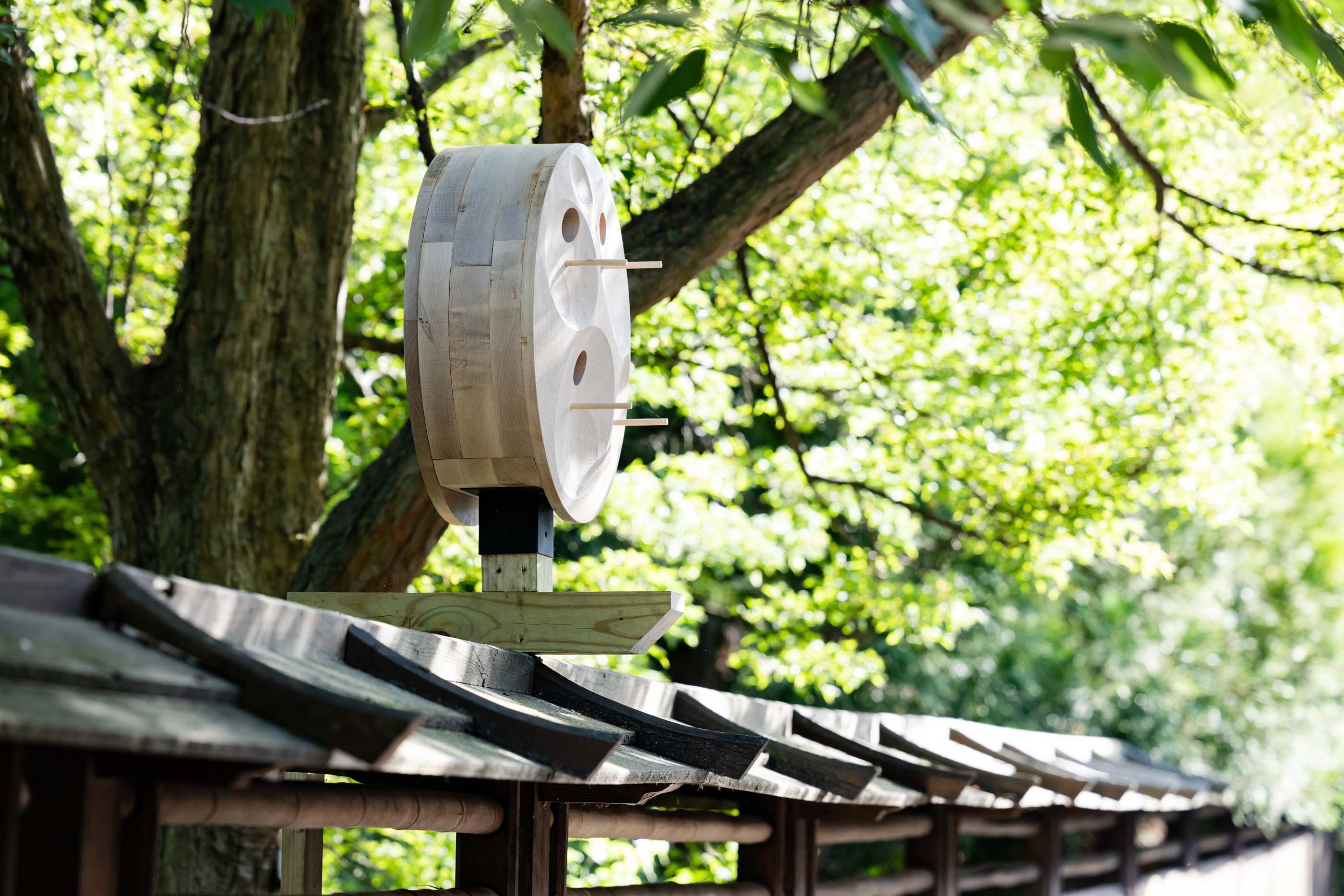
Of course, the expression “for the birds” has a double meaning: In vernacular speech, it suggests something is worthless or trivial. The BBG’s show is anything but. Motivated by today’s climate crisis, we know that our future depends on what we do for the birds.
For the Birds
Brooklyn Botanic Gardens
990 Washington Ave, Brooklyn, NY 11225
Open through October 23
Stephen Zacks is an architecture journalist and project organizer based in New York.









